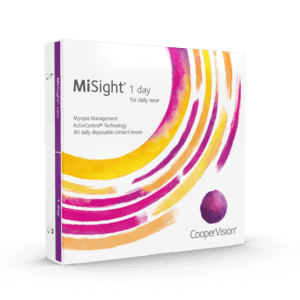
What is Myopia?
Myopia is also called near-sightedness. It means a person can see close objects well but cannot see clearly things in the distance without glasses or contact lenses. How far away a person can see without glasses depends on how severe the myopia is. Nearsightedness is common. About 30% of all people have myopia but is up to 49% worldwide. It usually starts during the school-age years.
What causes myopia?
Doctors are not sure what causes myopia. It is often hereditary. Some research has shown prolonged reading or near work and reduced amounts of outdoor time are associated with myopia.
Can myopia be prevented?
There is no way at this time to prevent myopia, but recent studies have shown there may be ways to slow its progression. Wearing glasses does not seem to affect the myopia or its development.
- Increase daylight exposure
- Reduce prolonged intense periods of near work
- MiSight 1-day soft lenses are the first FDA approved soft contact lens to slow the progression of myopia. Over a 3 year period, MiSight® 1 day slowed the progression of myopia in children aged 8-12 at the initiation of treatment by 59% on average, and 41% of eyes had no progression.*1
- Use diluted atropine eyedrops: Atropine 0.01% slows myopia progression by at least 50%. Atropine in higher concentrations also slows progression but also can cause pupil dilation, light sensitivity, and blurred vision. Atropine 0.01% solution causes minimal pupil dilation, no light sensitivity, and no near visual loss compared with higher doses. The treatment time period in published studies was 2-3 years, but it may require longer period of time since the eyes are still growing through the teenage years. Make sure to use atropine under a doctor’s guidance.
- Orthokeratology (OrthoK): Wearing reverse geometry contact lenses overnight temporarily flattens the cornea and provides clear vision during the day without glasses or contact lenses. Reduction in myopia (up to −6 D) can be achieved, but it is not clear whether the effect is sustained after stopping the OrthoK. A few studies have shown permanent changes consistent with reduced myopia. Unfortunately, sleeping in contact lenses increases the risk of bacterial corneal infection which can be very serious and cause scarring and permanent visual impairment.
How is myopia treated?
Depending on the age of the child and the severity of the myopia, glasses are usually the first treatment. Young children usually handle myopia well and most often do not require glasses because most of their world is in arm's reach. By school age, distance vision becomes more important and myopia more disabling. Children with myopia often wear glasses only for reading the blackboard and remove them when reading books or playing. This is OK. Myopia usually increases through the late teenage years and glasses often become more necessary as a child becomes older.
What about contact lenses?
Once a child is wearing glasses most of the time, contact lenses are a reasonable option. They require motivation on the part of the parent and the child. There is no magic age at which contacts become "OK". In general, when a child is old enough to remember to brush their teeth every night without being reminded and clean their room without being told, they probably are responsible enough to care for contact lenses.
We are certified providers in CooperVision’s Brilliant Futures™ Myopia Management Program. The cornerstone of this comprehensive approach to myopia management in pediatric patients is the MiSight® 1 day contact lens – the first and only contact lens approved by the FDA to slow myopia progression in children, aged 8-12 at the initiation of treatment.1
The correlation between increasing myopia and potentially vision-threatening complications later in life is well established and is a growing concern for both eye care practitioners and parents worldwide.2 Here in the United States, the rate of myopia occurrence has increased from 25% to 42% over the last two generations.3 This is due to a combination of genetic and lifestyle factors.

MiSight® 1 day contact lenses have been shown in a multi-year clinical trial to reduce the average rate of progression of myopia by 59%,1 which means that the relative risk of a myopia-associated pathology can be significantly reduced.4 This convenient, daily disposable contact lens is well-accepted by children and does not affect their daily activities. It is designed to be worn for ten or more hours per day, six or more days per week to get the maximum treatment effect.
We are very excited to offer the Brilliant Futures™ Myopia Management Program to our patients and we hope that you will join us in our efforts to combat pediatric myopia for a brighter tomorrow. If you would like any further information on managing myopia in children, please don’t hesitate to get in touch with me.
Contacts require separate fitting and teaching appointments. The glasses prescription can be used to determine the power of the lenses, but additional measurements are required. Refractive laser surgery is not recommended for mild to moderate myopia in children under 18 years of age because the eyes are still growing. Refractive surgery is only appropriate in children when one or both eyes have severe myopia, and the child cannot or will not wear glasses due to severe tactile aversion.

Indications for use: MiSight® 1 day (omafilcon A) soft (hydrophilic) contact lenses for daily wear are indicated for the correction of myopic ametropia and for slowing the progression of myopia in children with non-diseased eyes, who at the initiation of treatment are 8-12 years of age and have a refraction of -0.75 to -4.00 diopters (spherical equivalent) with ≤ 0.75 diopters of astigmatism. The lens is to be discarded after each removal. References: 1. Chamberlain P, et al. A 3-year randomized clinical trial of MiSight lenses for myopia control. Optom Vis Sci. 2019;96:556–567. 2. CONSORT 2010 Explanation and Elaboration: Updated guidelines for reporting parallel group randomized trials BMJ. 2010;340:c869 doi: 10.1136/bmj.c869. 3. Chamberlain P, Arumugam B, Jones D et al. Myopia Progression in Children wearing Dual-Focus Contact Lenses: 6-year findings. Optom Vis Sci 2020;97(E-abstract): 200038. 4. Tideman J, et al. Association of axial length with risk of uncorrectable visual impairment for Europeans with myopia. JAMA Ophthalmol. 2016;134:1355-1363. 5. Woods, Jill et al. Ocular health of children wearing daily disposable contact lenses over a 6-year period. Contact Lens and Anterior Eye, Volume 0, Issue 0, 2021. MiSight® 1 day, Proclear® 1 day, and CooperVision® are registered trademarks and trademarks of The Cooper Companies, Inc. and its subsidiaries. ©2021 CooperVision. 10663 03/21
